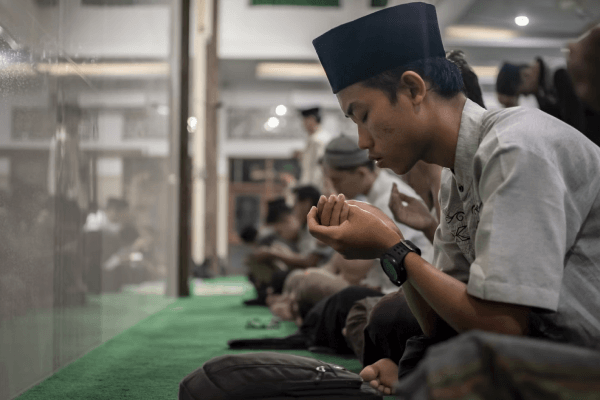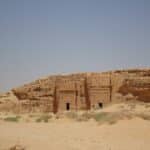Battle of Buhran – Patrolling Invasion
In the expansive canvas of Islamic history, the Invasion of Buhran emerges as a crucial juncture during the time of Prophet Muhammad (s). Referred to as the Battle of al-Fur’ and the Battle of Bani Sulaym, this expedition, though devoid of direct military confrontation, holds profound significance in the strategic measures the Prophet and his Muslim companions.
This exploration seeks to delve deeper into the layers of this historical event, unravelling the situation’s complexities and the wisdom behind the Prophet Muhammad’s (PBUH) actions.
The Historical Landscape: Banu Sulaym
To grasp the full context of the Invasion of Buhran, understanding the role of the Banu Sulaym is essential. Their imprint on early Islamic history is notable, extending to their involvement in the Muslim conquest of Syria and the subsequent establishment in the Jazira.
The historical landscape of the Invasion of Buhran is intricately woven with the presence and influence of the Banu Sulaym. This Arab tribe held a dominant position in the pre-Islamic Hejaz region.
To comprehend the full scope of the context surrounding this pivotal event, it is imperative to delve into the rich history and significance of the Banu Sulaym.

Origins and Early Hegemony
The Banu Sulaym trace their lineage to the larger umbrella of Arab tribes, establishing their roots in the Arabian Peninsula.
Before the advent of Islam, the Banu Sulaym’s prominence was particularly felt in the Hejazi region, where they maintained close connections with the Quraysh of Mecca and the inhabitants of Madinah.
Their nomadic lifestyle and intricate tribal structure positioned them as key players in the socio-political dynamics of the time.
Battles and Alliances
The Banu Sulaym were not passive observers but active participants in the tumultuous events that unfolded in pre-Islamic Arabia.
Their historical narrative includes engagements in battles against Prophet Muhammad (PBUH), rejecting the notion of monotheism and being utterly against Muslims before the eventual embrace of Islam in 632 CE.
This transition from adversaries to followers marked a significant chapter in the tribe’s journey.
The Banu Sulaym’s strategic alliances, particularly with the Quraysh and other tribes, played a crucial role in shaping the political landscape of the Hejaz.
Their connections extended beyond mere geographical proximity, reflecting a complex web of alliances and rivalries that characterised the Arabian Peninsula during this era.
Conversion to Islam
The advent of Islam brought a transformative shift to the Banu Sulaym’s narrative. The tribe, once engaged in conflicts with Prophet Muhammad (SAW), underwent a profound change with the acceptance of Islam.
The year 632 CE witnessed a pivotal moment when the Banu Sulaym, like many other tribes, embraced the monotheistic teachings brought by the Prophet Muhammad (PBUH).
The reversion of the Banu Sulaym signalled a broader trend in the Arabian Peninsula, where tribes moved from animosities to alliances under the banner of Islam.
This shift in allegiance laid the foundation for unifying disparate tribes into a cohesive Islamic community.

Participation in Muslim Conquests
Banu Sulaym’s commitment to Islam extended beyond mere acceptance of the faith. They actively participated in the Muslim conquest of Syria, showcasing their martial prowess and allegiance to the nascent Muslim state.
This phase of conquests marked a period of territorial expansion, and the Banu Sulaym shaped the new geopolitical landscape.
Location and Context
The Invasion of Buhran unfolded in the Wadi l-Fur’ region of Hijaz, strategically positioned between Mecca and Madinah. Buhran, or Bahran, approximately 200 kilometres south of Madinah, became a focal point due to intelligence suggesting a potential conspiracy involving members of the Banu Sulaym tribe.
Reasons behind the Invasion
In 3 A.H. (624 CE), Prophet Muhammad (PBUH) received intelligence indicating a brewing conspiracy within the Banu Sulaym tribe in Buhran. Faced with this potential threat, the Prophet appointed Ibn Umm Maktum as his deputy in Madinah and led a force of three hundred soldiers to Buhran.
The primary objective was to thwart the alleged conspiracy and safeguard the security of the Muslim community.
The Strategic Expedition
Upon reaching Buhran, the Prophet and his companions encountered a dispersed Banu Sulaym, who had scattered in panic, avoiding direct confrontation.
Despite the absence of military combat, the strategic manoeuvre by the Prophet (PBUH) showcased his commitment to pre-emptively address potential threats to the stability of the Muslim community.

Commander and Leader of the Battle: Prophet Muhammad (PBUH)
Prophet Muhammad (SAW), born around 570 CE and passing away on June 8, 632 CE, was not merely a religious figure but also a social and political leader.
The final and seal of prophets, he is considered a Prophet divinely inspired to preach and confirm monotheistic teachings.
He is the beacon of light for all human beings, and a beam of guidance for Muslims. At the age of 54, during the Battle of Buhran, Prophet Muhammad’s (PBUH) leadership played a pivotal role in steering the nascent Muslim community through myriad challenges.
The Prophet returned with admirable success and triumph alongside his loyal Muslim companions.
Date and Duration
Historical sources provide varying dates for the Invasion of Buhran. Some Muslims propose its occurrence at the beginning of Rabi’ II (September-October).
In contrast, others suggest the 6th of Jumada I or Jumada II (October 25 or November 24) in the year 3 A.H. Regardless of the exact date, the Prophet (SAW) spent ten or eleven days outside Madinah, addressing the situation with strategic insight.
Significance of the Battle of Buhran
The Invasion of Buhran is paramount in the broader context of Prophet Muhammad’s (SAW) strategic approach to safeguarding the Muslim community. The expedition of Buhran, Prophet Muhammad’s (SAW) campaign, is classified as one of the eleven ghazwas (expeditions) where no military combat occurred.
The episode underscores the Prophet’s ability to deter potential threats through strategic actions without resorting to violence, showcasing his diplomatic finesse and leadership skills.
Here again, Prophet Muhammad (SAW) set an elite example for Muslims to gather peace and harmony without the use of force.
The socio-political landscape of early Islamic society also had a crucial role in shaping the significance of this expedition. The Arabian Peninsula was a tapestry of tribes and alliances, and the Banu Sulaym’s involvement added a layer of complexity to the delicate equilibrium.
Let’s delve into the multifaceted layers that render the Battle of Buhran a crucial chapter in the early history of Islam.

Preventing a Potential Conspiracy
- The primary motive behind the Battle of Buhran was to preemptively address intelligence about a brewing conspiracy within the Banu Sulaym tribe. Prophet Muhammad (PBUH) received information that members of the tribe were planning a conspiracy in the region of Buhran against the Muslim community.
- By taking proactive measures and leading a force of three hundred soldiers to Buhran, the Prophet aimed to thwart any potential threat to the stability and security of the Muslim community in Madinah.
Diplomacy over Confrontation
- Unlike many other battles of the time, the Battle of Buhran did not involve direct military confrontation. The Banu Sulaym scattered in panic upon the arrival of the Muslim force, avoiding bloodshed.
- This episode highlights Prophet Muhammad’s (PBUH) preference for diplomatic solutions when possible, underscoring the importance of resolving conflicts through dialogue and strategic manoeuvres rather than resorting to violence.
Strategic Acumen of Prophet Muhammad (PBUH)
- The Battle of Buhran showcases the strategic understanding of Prophet Muhammad (PBUH). Despite the absence of direct military engagement, the Prophet’s decision to investigate and address potential threats before they escalated demonstrated his keen understanding of the importance of preventive measures in maintaining the stability of the Muslim community.
Diplomacy over Confrontation
- Unlike many other battles of the time, the Battle of Buhran did not involve direct military confrontation. The Banu Sulaym scattered in panic upon the arrival of the Muslim force, avoiding bloodshed.
- This episode highlights Prophet Muhammad’s (SAW) preference for diplomatic solutions, underscoring the importance of resolving conflicts through dialogue and strategic manoeuvres rather than resorting to violence.
To Sum Up – Battle of Buhran
The Invasion of Buhran is a testament to Prophet Muhammad’s (PBUH) unwavering commitment to ensuring the security and stability of the early Muslim community. His proactive response to a potential conspiracy reflects strategic acumen and profound leadership.
This lesser-known episode enriches our understanding of the challenges the developing Islamic community faces and the nuanced measures taken to overcome them.
Furthermore, the involvement of the Banu Sulaym adds depth to the narrative, emphasising the broader socio-political context in which the Invasion of Buhran unfolded.
Their intricate role in early Islamic history, from battles against Prophet Muhammad (PBUH) to their eventual conversion and participation in subsequent conquests, highlights the interconnectedness of tribes and communities during this transformative period.
In examining the Invasion of Buhran, we unravel a strategic chapter in Islamic history and a multifaceted tale of leadership, diplomacy, and the dynamic relationships that shaped the course of the burgeoning Muslim community.
The resonance of this event extends beyond its historical confines, offering timeless lessons in navigating challenges with wisdom and foresight.
As we reflect on the intricate dynamics at play during the Invasion of Buhran, we gain insights into the delicate balance maintained by Prophet Muhammad (PBUH) in navigating the socio-political landscape of early Islamic society.
The Banu Sulaym, as a key player in this narrative, symbolise the interconnectedness of tribes and the transformative journey of communities during this crucial period.
The Invasion of Buhran serves as a beacon illuminating the strategic prowess of Prophet Muhammad (PBUH) and the intricate tapestry of relationships and alliances that shaped early Islamic history.
Through this exploration and unchallenged expeditions, we glean timeless lessons in leadership, diplomacy, and the art of navigating challenges with wisdom and foresight, ensuring that the legacy of the Invasion of Buhran continues to echo in the pages of Islamic history.
The Invasion of Buhran also holds an unquestionable lesson for the Muslims of that era and after.
Through His Names
New course with
Ustadh Shabbir Hassan















